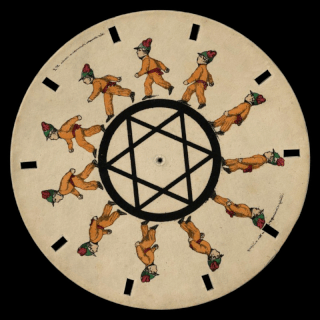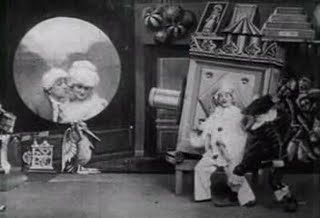
The magic lantern, also known by its Latin name lanterna magica, is an early type of image projector that used pictures—paintings, prints, or photographs—on transparent plates, one or more lenses, and a light source. It was mostly developed in the 17th century and commonly used for entertainment purposes. It was increasingly used for education during the 19th century. Since the late 19th century, smaller versions were also mass-produced as toys. The magic lantern was in wide use from the 18th century until the mid-20th century when it was superseded by a compact version that could hold many 35 mm photographic slides: the slide projector.

Morphing is a special effect in motion pictures and animations that changes one image or shape into another through a seamless transition. Traditionally such a depiction would be achieved through dissolving techniques on film. Since the early 1990s, this has been replaced by computer software to create more realistic transitions. A similar method is applied to audio recordings in similar fashion, for example, by changing voices or vocal lines.

A slide projector is an opto-mechanical device for showing photographic slides.

A stereopticon is a slide projector or relatively powerful "magic lantern", which has two lenses, usually one above the other, and has mainly been used to project photographic images. These devices date back to the mid 19th century, and were a popular form of entertainment and education before the advent of moving pictures.

The phénakisticope was the first widespread animation device that created a fluent illusion of motion. Dubbed "Fantascope" and "Stroboscopische Scheiben" by its inventors, it has been known under very many other names until the French product name Phenakisticope became common. The phenakistiscope is regarded as one of the first forms of moving media entertainment that paved the way for the future motion picture and film industry. Like a GIF animation, it can only show a short continuous loop.

A slide show is a presentation of a series of still images on a projection screen or electronic display device, typically in a prearranged sequence. The changes may be automatic and at regular intervals or they may be manually controlled by a presenter or the viewer. Slide shows originally consisted of a series of individual photographic slides projected onto a screen with a slide projector. When referring to the video or computer-based visual equivalent, in which the slides are not individual physical objects, the term is often written as one word, slideshow.

Phantasmagoria was a form of horror theatre that used one or more magic lanterns to project frightening images such as skeletons, demons, and ghosts onto walls, smoke, or semi-transparent screens, typically using rear projection to keep the lantern out of sight. Mobile or portable projectors were used, allowing the projected image to move and change size on the screen, and multiple projecting devices allowed for quick switching of different images. In many shows the use of spooky decoration, total darkness, (auto-)suggestive verbal presentation, and sound effects were also key elements. Some shows added a variety of sensory stimulation, including smells and electric shocks. Even required fasting, fatigue and drugs have been mentioned as methods of making sure spectators would be more convinced of what they saw. The shows started under the guise of actual séances in Germany in the late 18th century, and gained popularity through most of Europe throughout the 19th century.

Precursors of film are concepts and devices that have much in common with the later art and techniques of cinema.

Miniature faking, also known as diorama effect or diorama illusion, is a process in which a photograph of a life-size location or object is made to look like a photograph of a miniature scale model. Blurring parts of the photo simulates the shallow depth of field normally encountered in close-up photography, making the scene seem much smaller than it actually is; the blurring can be done either optically when the photograph is taken, or by digital postprocessing. Many diorama effect photographs are taken from a high angle to simulate the effect of looking down on a miniature. Tilt–shift photography is also associated with miniature faking.

Étienne-Gaspard Robert, often known by the stage name of "Robertson", was a prominent Belgian physicist, stage magician and influential developer of phantasmagoria. He was described by Charles Dickens as "an honourable and well-educated showman". Alongside his pioneering work on projection techniques for his shows Robert was also a physics lecturer and a keen balloonist at a time of great development in aviation.

The Museum of Precinema is a museum in the Palazzo Angeli, Prato della Valle, Padua, Italy, related to the history of precinema, or precursors of film. It was created in 1998 to display the Minici Zotti Collection, in collaboration with the Comune di Padova. It also produces interactive touring exhibitions and makes valuable loans to other prestigious exhibitions such as 'Lanterne magique et film peint' at the Cinémathèque Française in Paris and the Museum of Cinema in Turin.

A projector or image projector is an optical device that projects an image onto a surface, commonly a projection screen. Most projectors create an image by shining a light through a small transparent lens, but some newer types of projectors can project the image directly, by using lasers. A virtual retinal display, or retinal projector, is a projector that projects an image directly on the retina instead of using an external projection screen.

Phylidor, also spelled "Phylidoor" or "Philidor", also known as "Paul Filidort" and probably the same as Paul de Philipsthal, was a magician and a pioneer of phantasmagoria shows.

Carpenter and Westley were a British optical, mathematical and scientific instrument makers between 1808 and 1914. The company was founded by Philip Carpenter and, after his death, was continued by his sister Mary Carpenter alongside former apprentice William Westley. The company's contribution to the development of magic lanterns was significant and Philip Carpenter pioneered the use of copperplate slides.
Edmé-Gilles Guyot (1706–1786) was a French mail clerk, physician, postmaster, cartographer, inventor and author on the subject of mathematics, physics and magic. He experimented with optical illusions and with the theory behind performance magic. His developments into the apparent appearance of ghosts, using the projection of a figure into smoke, helped to create the technology and techniques used in phantasmagoria.
Elias Childe (1778–1849) was a British landscape painter. He was a prolific artist, working both in oils and watercolours.
Henry Langdon Childe (1781–1874) was an English showman, known as a developer of the magic lantern and dissolving views, a precursor of the dissolve in cinematic technique. While the priority question on the technical innovations Childe used is still debated, he established the use of double and triple lanterns for special theatrical effects, to the extent that the equipment involved became generally available through suppliers to other professionals. By the 1840s the "dissolving view", rooted in Gothic horror, had become a staple of illustrated talks with restrained animations.
The etymological meaning of the word audiovisualogy is linked, on the one hand, with the term audiovisual, referring to the means jointly related to the view and the hearing and, on the other hand, to the suffix logy, that refers to logos, and that in Greek means treaty, knowledge. Therefore, audiovisualogy must be understood as a study of the audiovisual media that, due to its broad meaning, could be related to either the cinema, the television or any other art.
A chromatrope is a type of magic lantern slide that produces dazzling, colorful geometrical patterns set in motion by rotating two painted glass discs in opposite directions, originally with a double pulley mechanism but later usually with a rackwork mechanism.

La Lanterne magique, sold in the United States as The Magic Lantern and in Britain as The Magic Lantern, or the Bioscope in the Toy Shop, is a 1903 French short silent film by Georges Méliès. It was sold by Méliès's Star Film Company and is numbered 520–524 in its catalogues.













